University Business Law ILAC Problem Question Assignment
VerifiedAdded on 2023/01/11
|9
|2052
|82
Homework Assignment
AI Summary
This document provides a detailed solution to a business law problem question, employing the ILAC (Issues, Law, Application, Conclusion) method. The assignment analyzes two case studies involving potential negligence and breach of duty, with a focus on financial advisors and manufacturers. The solution examines the elements of negligence, including duty of care, breach, causation, and damages, referencing relevant case law such as Donoghue v Stevenson and Civil Liability Act 2002. The analysis explores vicarious liability, professional standards, and the potential for pecuniary and non-pecuniary damages. The document provides a comprehensive understanding of legal principles and their application in resolving complex business law scenarios. The first case explores the liability of a financial advisor, Slonia, for negligent advice leading to business failure. The second case examines the liability of a manufacturer, AJ, Weldon, and Mechanangello, for a defective product causing physical injury and financial loss. The analysis covers various legal aspects and offers a clear understanding of the legal concepts and their applications in the given scenarios.
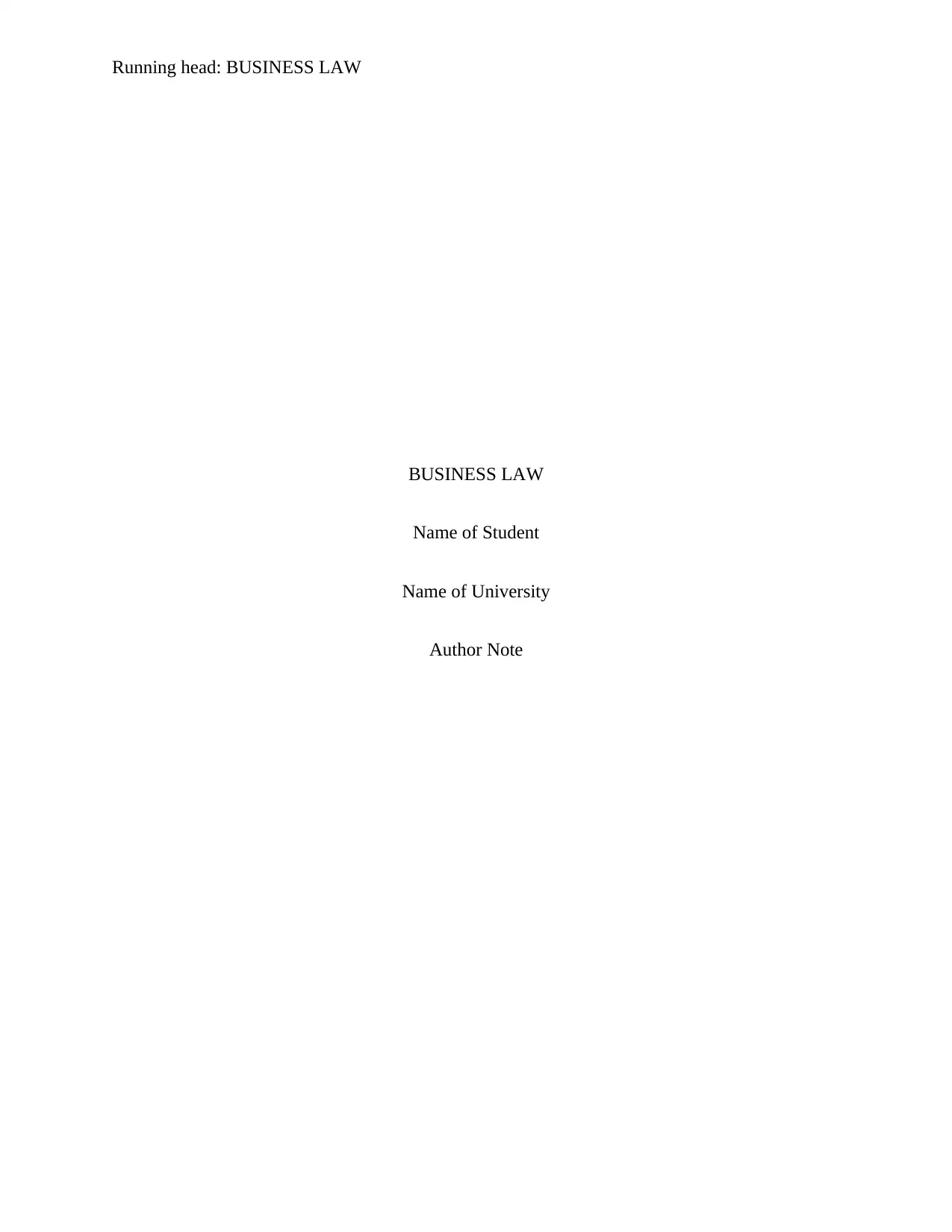
Running head: BUSINESS LAW
BUSINESS LAW
Name of Student
Name of University
Author Note
BUSINESS LAW
Name of Student
Name of University
Author Note
Paraphrase This Document
Need a fresh take? Get an instant paraphrase of this document with our AI Paraphraser
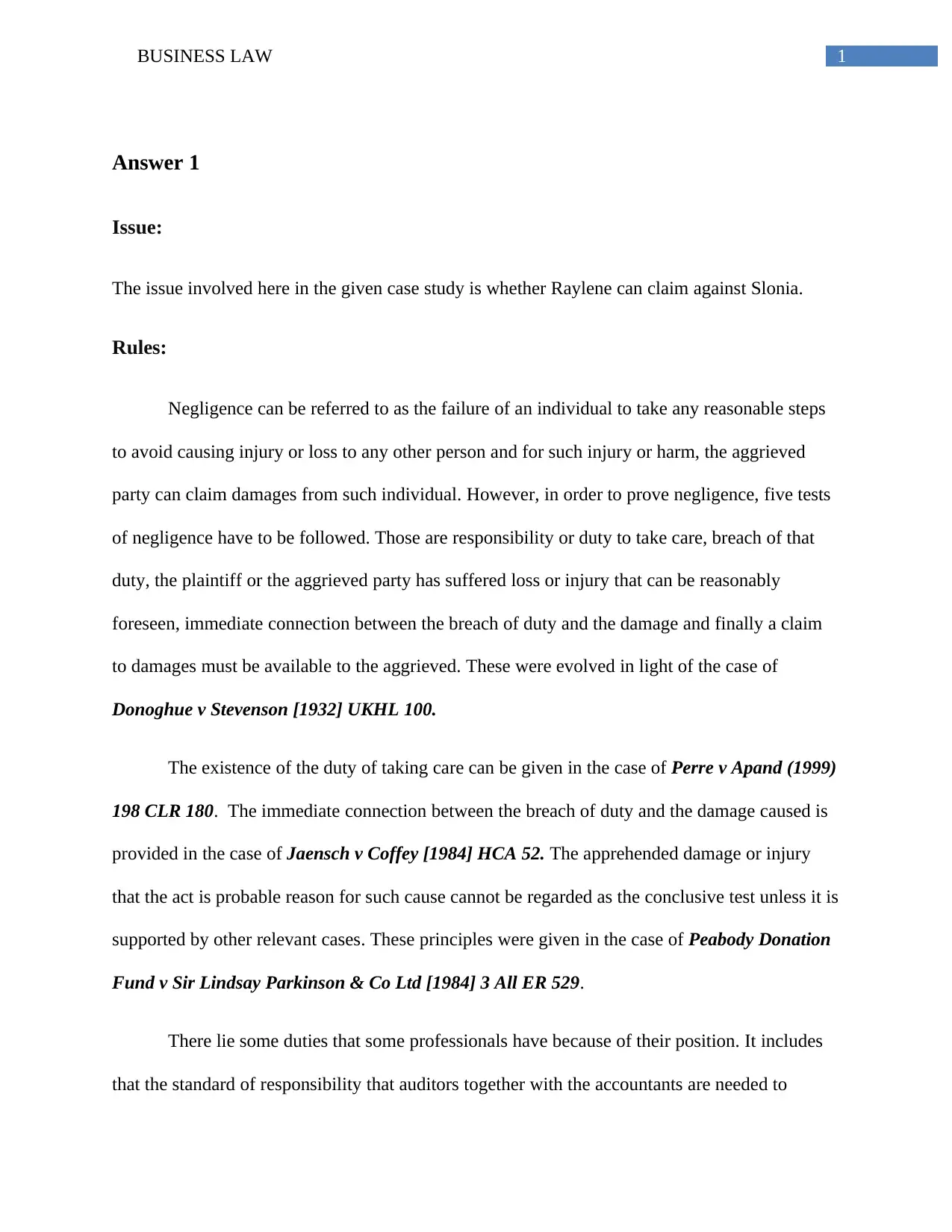
1BUSINESS LAW
Answer 1
Issue:
The issue involved here in the given case study is whether Raylene can claim against Slonia.
Rules:
Negligence can be referred to as the failure of an individual to take any reasonable steps
to avoid causing injury or loss to any other person and for such injury or harm, the aggrieved
party can claim damages from such individual. However, in order to prove negligence, five tests
of negligence have to be followed. Those are responsibility or duty to take care, breach of that
duty, the plaintiff or the aggrieved party has suffered loss or injury that can be reasonably
foreseen, immediate connection between the breach of duty and the damage and finally a claim
to damages must be available to the aggrieved. These were evolved in light of the case of
Donoghue v Stevenson [1932] UKHL 100.
The existence of the duty of taking care can be given in the case of Perre v Apand (1999)
198 CLR 180. The immediate connection between the breach of duty and the damage caused is
provided in the case of Jaensch v Coffey [1984] HCA 52. The apprehended damage or injury
that the act is probable reason for such cause cannot be regarded as the conclusive test unless it is
supported by other relevant cases. These principles were given in the case of Peabody Donation
Fund v Sir Lindsay Parkinson & Co Ltd [1984] 3 All ER 529.
There lie some duties that some professionals have because of their position. It includes
that the standard of responsibility that auditors together with the accountants are needed to
Answer 1
Issue:
The issue involved here in the given case study is whether Raylene can claim against Slonia.
Rules:
Negligence can be referred to as the failure of an individual to take any reasonable steps
to avoid causing injury or loss to any other person and for such injury or harm, the aggrieved
party can claim damages from such individual. However, in order to prove negligence, five tests
of negligence have to be followed. Those are responsibility or duty to take care, breach of that
duty, the plaintiff or the aggrieved party has suffered loss or injury that can be reasonably
foreseen, immediate connection between the breach of duty and the damage and finally a claim
to damages must be available to the aggrieved. These were evolved in light of the case of
Donoghue v Stevenson [1932] UKHL 100.
The existence of the duty of taking care can be given in the case of Perre v Apand (1999)
198 CLR 180. The immediate connection between the breach of duty and the damage caused is
provided in the case of Jaensch v Coffey [1984] HCA 52. The apprehended damage or injury
that the act is probable reason for such cause cannot be regarded as the conclusive test unless it is
supported by other relevant cases. These principles were given in the case of Peabody Donation
Fund v Sir Lindsay Parkinson & Co Ltd [1984] 3 All ER 529.
There lie some duties that some professionals have because of their position. It includes
that the standard of responsibility that auditors together with the accountants are needed to
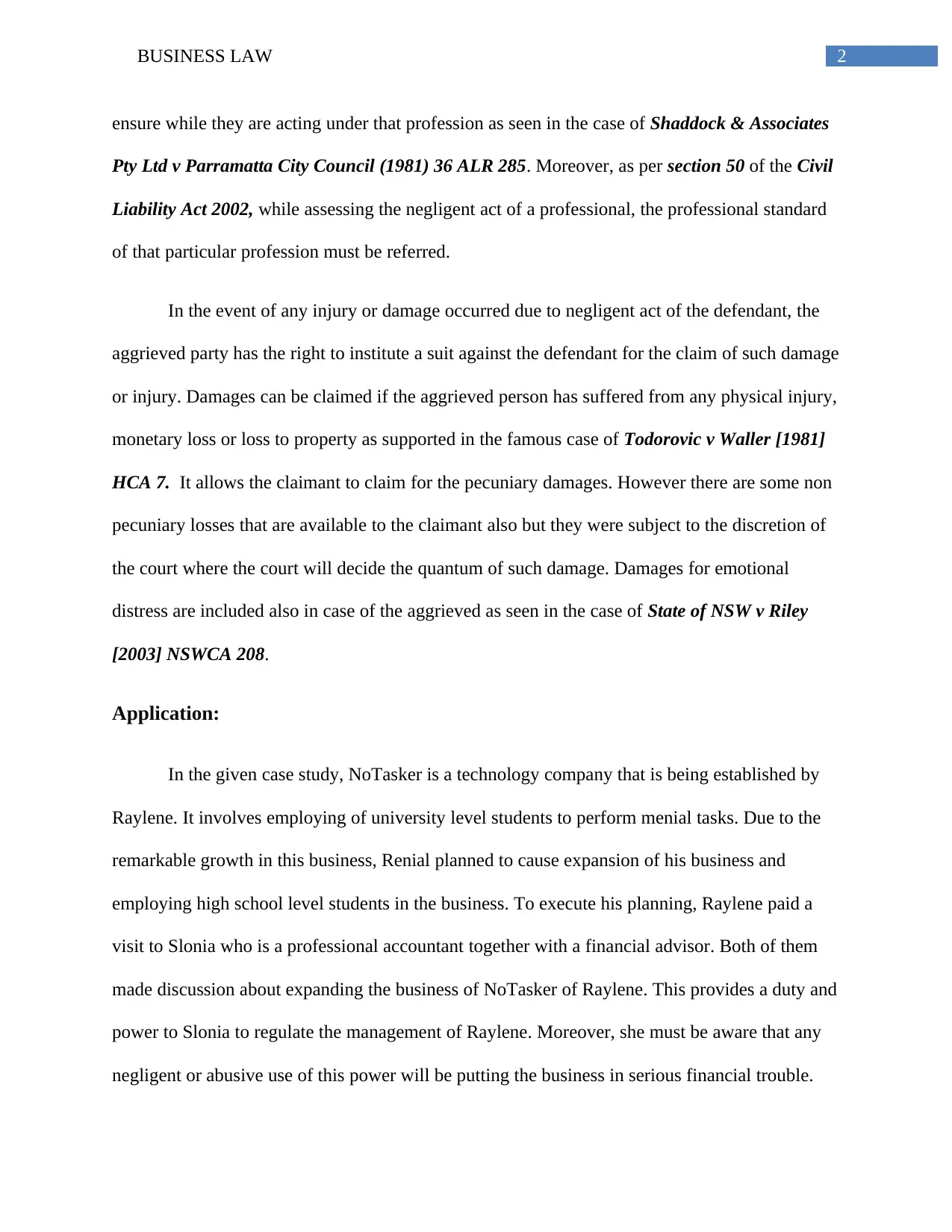
2BUSINESS LAW
ensure while they are acting under that profession as seen in the case of Shaddock & Associates
Pty Ltd v Parramatta City Council (1981) 36 ALR 285. Moreover, as per section 50 of the Civil
Liability Act 2002, while assessing the negligent act of a professional, the professional standard
of that particular profession must be referred.
In the event of any injury or damage occurred due to negligent act of the defendant, the
aggrieved party has the right to institute a suit against the defendant for the claim of such damage
or injury. Damages can be claimed if the aggrieved person has suffered from any physical injury,
monetary loss or loss to property as supported in the famous case of Todorovic v Waller [1981]
HCA 7. It allows the claimant to claim for the pecuniary damages. However there are some non
pecuniary losses that are available to the claimant also but they were subject to the discretion of
the court where the court will decide the quantum of such damage. Damages for emotional
distress are included also in case of the aggrieved as seen in the case of State of NSW v Riley
[2003] NSWCA 208.
Application:
In the given case study, NoTasker is a technology company that is being established by
Raylene. It involves employing of university level students to perform menial tasks. Due to the
remarkable growth in this business, Renial planned to cause expansion of his business and
employing high school level students in the business. To execute his planning, Raylene paid a
visit to Slonia who is a professional accountant together with a financial advisor. Both of them
made discussion about expanding the business of NoTasker of Raylene. This provides a duty and
power to Slonia to regulate the management of Raylene. Moreover, she must be aware that any
negligent or abusive use of this power will be putting the business in serious financial trouble.
ensure while they are acting under that profession as seen in the case of Shaddock & Associates
Pty Ltd v Parramatta City Council (1981) 36 ALR 285. Moreover, as per section 50 of the Civil
Liability Act 2002, while assessing the negligent act of a professional, the professional standard
of that particular profession must be referred.
In the event of any injury or damage occurred due to negligent act of the defendant, the
aggrieved party has the right to institute a suit against the defendant for the claim of such damage
or injury. Damages can be claimed if the aggrieved person has suffered from any physical injury,
monetary loss or loss to property as supported in the famous case of Todorovic v Waller [1981]
HCA 7. It allows the claimant to claim for the pecuniary damages. However there are some non
pecuniary losses that are available to the claimant also but they were subject to the discretion of
the court where the court will decide the quantum of such damage. Damages for emotional
distress are included also in case of the aggrieved as seen in the case of State of NSW v Riley
[2003] NSWCA 208.
Application:
In the given case study, NoTasker is a technology company that is being established by
Raylene. It involves employing of university level students to perform menial tasks. Due to the
remarkable growth in this business, Renial planned to cause expansion of his business and
employing high school level students in the business. To execute his planning, Raylene paid a
visit to Slonia who is a professional accountant together with a financial advisor. Both of them
made discussion about expanding the business of NoTasker of Raylene. This provides a duty and
power to Slonia to regulate the management of Raylene. Moreover, she must be aware that any
negligent or abusive use of this power will be putting the business in serious financial trouble.
⊘ This is a preview!⊘
Do you want full access?
Subscribe today to unlock all pages.

Trusted by 1+ million students worldwide
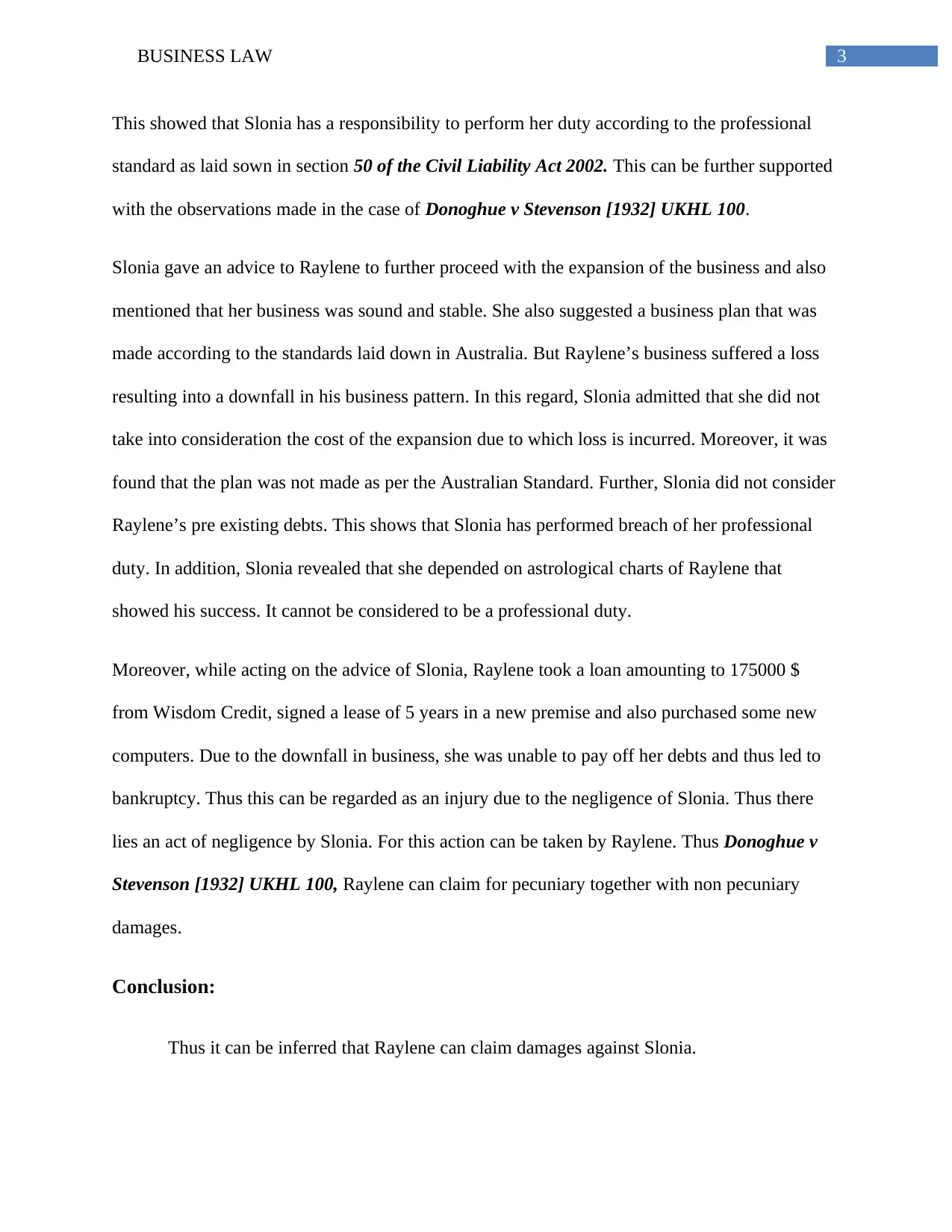
3BUSINESS LAW
This showed that Slonia has a responsibility to perform her duty according to the professional
standard as laid sown in section 50 of the Civil Liability Act 2002. This can be further supported
with the observations made in the case of Donoghue v Stevenson [1932] UKHL 100.
Slonia gave an advice to Raylene to further proceed with the expansion of the business and also
mentioned that her business was sound and stable. She also suggested a business plan that was
made according to the standards laid down in Australia. But Raylene’s business suffered a loss
resulting into a downfall in his business pattern. In this regard, Slonia admitted that she did not
take into consideration the cost of the expansion due to which loss is incurred. Moreover, it was
found that the plan was not made as per the Australian Standard. Further, Slonia did not consider
Raylene’s pre existing debts. This shows that Slonia has performed breach of her professional
duty. In addition, Slonia revealed that she depended on astrological charts of Raylene that
showed his success. It cannot be considered to be a professional duty.
Moreover, while acting on the advice of Slonia, Raylene took a loan amounting to 175000 $
from Wisdom Credit, signed a lease of 5 years in a new premise and also purchased some new
computers. Due to the downfall in business, she was unable to pay off her debts and thus led to
bankruptcy. Thus this can be regarded as an injury due to the negligence of Slonia. Thus there
lies an act of negligence by Slonia. For this action can be taken by Raylene. Thus Donoghue v
Stevenson [1932] UKHL 100, Raylene can claim for pecuniary together with non pecuniary
damages.
Conclusion:
Thus it can be inferred that Raylene can claim damages against Slonia.
This showed that Slonia has a responsibility to perform her duty according to the professional
standard as laid sown in section 50 of the Civil Liability Act 2002. This can be further supported
with the observations made in the case of Donoghue v Stevenson [1932] UKHL 100.
Slonia gave an advice to Raylene to further proceed with the expansion of the business and also
mentioned that her business was sound and stable. She also suggested a business plan that was
made according to the standards laid down in Australia. But Raylene’s business suffered a loss
resulting into a downfall in his business pattern. In this regard, Slonia admitted that she did not
take into consideration the cost of the expansion due to which loss is incurred. Moreover, it was
found that the plan was not made as per the Australian Standard. Further, Slonia did not consider
Raylene’s pre existing debts. This shows that Slonia has performed breach of her professional
duty. In addition, Slonia revealed that she depended on astrological charts of Raylene that
showed his success. It cannot be considered to be a professional duty.
Moreover, while acting on the advice of Slonia, Raylene took a loan amounting to 175000 $
from Wisdom Credit, signed a lease of 5 years in a new premise and also purchased some new
computers. Due to the downfall in business, she was unable to pay off her debts and thus led to
bankruptcy. Thus this can be regarded as an injury due to the negligence of Slonia. Thus there
lies an act of negligence by Slonia. For this action can be taken by Raylene. Thus Donoghue v
Stevenson [1932] UKHL 100, Raylene can claim for pecuniary together with non pecuniary
damages.
Conclusion:
Thus it can be inferred that Raylene can claim damages against Slonia.
Paraphrase This Document
Need a fresh take? Get an instant paraphrase of this document with our AI Paraphraser
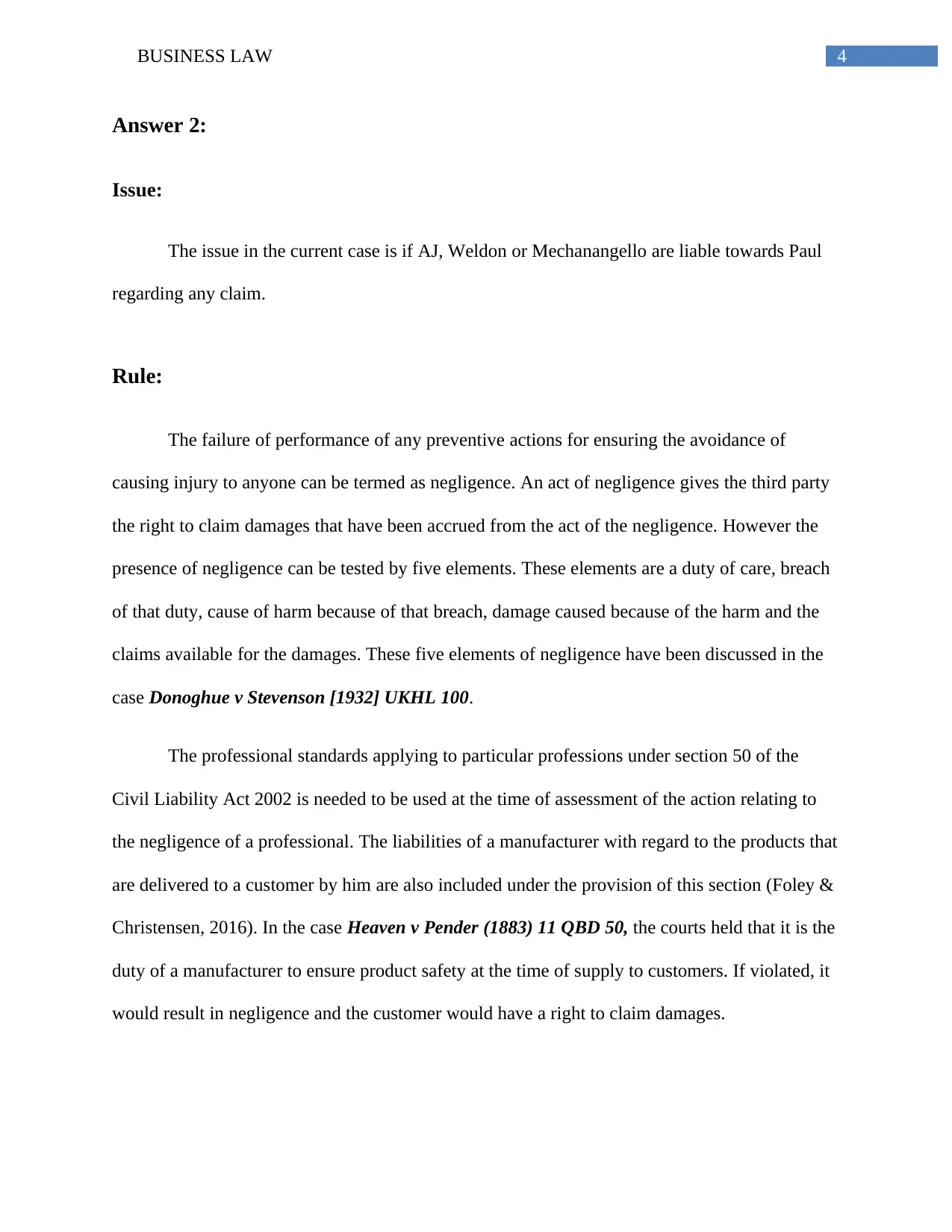
4BUSINESS LAW
Answer 2:
Issue:
The issue in the current case is if AJ, Weldon or Mechanangello are liable towards Paul
regarding any claim.
Rule:
The failure of performance of any preventive actions for ensuring the avoidance of
causing injury to anyone can be termed as negligence. An act of negligence gives the third party
the right to claim damages that have been accrued from the act of the negligence. However the
presence of negligence can be tested by five elements. These elements are a duty of care, breach
of that duty, cause of harm because of that breach, damage caused because of the harm and the
claims available for the damages. These five elements of negligence have been discussed in the
case Donoghue v Stevenson [1932] UKHL 100.
The professional standards applying to particular professions under section 50 of the
Civil Liability Act 2002 is needed to be used at the time of assessment of the action relating to
the negligence of a professional. The liabilities of a manufacturer with regard to the products that
are delivered to a customer by him are also included under the provision of this section (Foley &
Christensen, 2016). In the case Heaven v Pender (1883) 11 QBD 50, the courts held that it is the
duty of a manufacturer to ensure product safety at the time of supply to customers. If violated, it
would result in negligence and the customer would have a right to claim damages.
Answer 2:
Issue:
The issue in the current case is if AJ, Weldon or Mechanangello are liable towards Paul
regarding any claim.
Rule:
The failure of performance of any preventive actions for ensuring the avoidance of
causing injury to anyone can be termed as negligence. An act of negligence gives the third party
the right to claim damages that have been accrued from the act of the negligence. However the
presence of negligence can be tested by five elements. These elements are a duty of care, breach
of that duty, cause of harm because of that breach, damage caused because of the harm and the
claims available for the damages. These five elements of negligence have been discussed in the
case Donoghue v Stevenson [1932] UKHL 100.
The professional standards applying to particular professions under section 50 of the
Civil Liability Act 2002 is needed to be used at the time of assessment of the action relating to
the negligence of a professional. The liabilities of a manufacturer with regard to the products that
are delivered to a customer by him are also included under the provision of this section (Foley &
Christensen, 2016). In the case Heaven v Pender (1883) 11 QBD 50, the courts held that it is the
duty of a manufacturer to ensure product safety at the time of supply to customers. If violated, it
would result in negligence and the customer would have a right to claim damages.
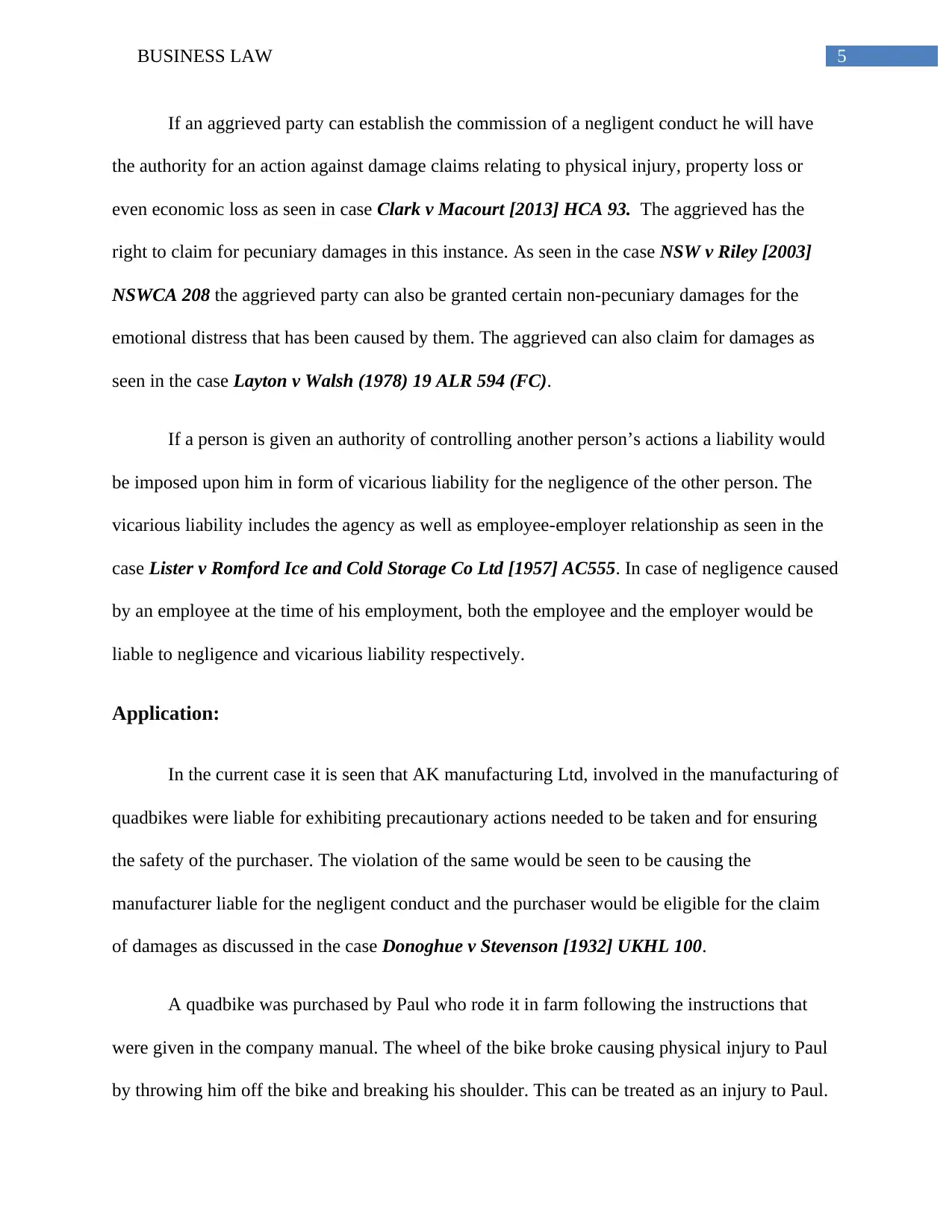
5BUSINESS LAW
If an aggrieved party can establish the commission of a negligent conduct he will have
the authority for an action against damage claims relating to physical injury, property loss or
even economic loss as seen in case Clark v Macourt [2013] HCA 93. The aggrieved has the
right to claim for pecuniary damages in this instance. As seen in the case NSW v Riley [2003]
NSWCA 208 the aggrieved party can also be granted certain non-pecuniary damages for the
emotional distress that has been caused by them. The aggrieved can also claim for damages as
seen in the case Layton v Walsh (1978) 19 ALR 594 (FC).
If a person is given an authority of controlling another person’s actions a liability would
be imposed upon him in form of vicarious liability for the negligence of the other person. The
vicarious liability includes the agency as well as employee-employer relationship as seen in the
case Lister v Romford Ice and Cold Storage Co Ltd [1957] AC555. In case of negligence caused
by an employee at the time of his employment, both the employee and the employer would be
liable to negligence and vicarious liability respectively.
Application:
In the current case it is seen that AK manufacturing Ltd, involved in the manufacturing of
quadbikes were liable for exhibiting precautionary actions needed to be taken and for ensuring
the safety of the purchaser. The violation of the same would be seen to be causing the
manufacturer liable for the negligent conduct and the purchaser would be eligible for the claim
of damages as discussed in the case Donoghue v Stevenson [1932] UKHL 100.
A quadbike was purchased by Paul who rode it in farm following the instructions that
were given in the company manual. The wheel of the bike broke causing physical injury to Paul
by throwing him off the bike and breaking his shoulder. This can be treated as an injury to Paul.
If an aggrieved party can establish the commission of a negligent conduct he will have
the authority for an action against damage claims relating to physical injury, property loss or
even economic loss as seen in case Clark v Macourt [2013] HCA 93. The aggrieved has the
right to claim for pecuniary damages in this instance. As seen in the case NSW v Riley [2003]
NSWCA 208 the aggrieved party can also be granted certain non-pecuniary damages for the
emotional distress that has been caused by them. The aggrieved can also claim for damages as
seen in the case Layton v Walsh (1978) 19 ALR 594 (FC).
If a person is given an authority of controlling another person’s actions a liability would
be imposed upon him in form of vicarious liability for the negligence of the other person. The
vicarious liability includes the agency as well as employee-employer relationship as seen in the
case Lister v Romford Ice and Cold Storage Co Ltd [1957] AC555. In case of negligence caused
by an employee at the time of his employment, both the employee and the employer would be
liable to negligence and vicarious liability respectively.
Application:
In the current case it is seen that AK manufacturing Ltd, involved in the manufacturing of
quadbikes were liable for exhibiting precautionary actions needed to be taken and for ensuring
the safety of the purchaser. The violation of the same would be seen to be causing the
manufacturer liable for the negligent conduct and the purchaser would be eligible for the claim
of damages as discussed in the case Donoghue v Stevenson [1932] UKHL 100.
A quadbike was purchased by Paul who rode it in farm following the instructions that
were given in the company manual. The wheel of the bike broke causing physical injury to Paul
by throwing him off the bike and breaking his shoulder. This can be treated as an injury to Paul.
⊘ This is a preview!⊘
Do you want full access?
Subscribe today to unlock all pages.

Trusted by 1+ million students worldwide
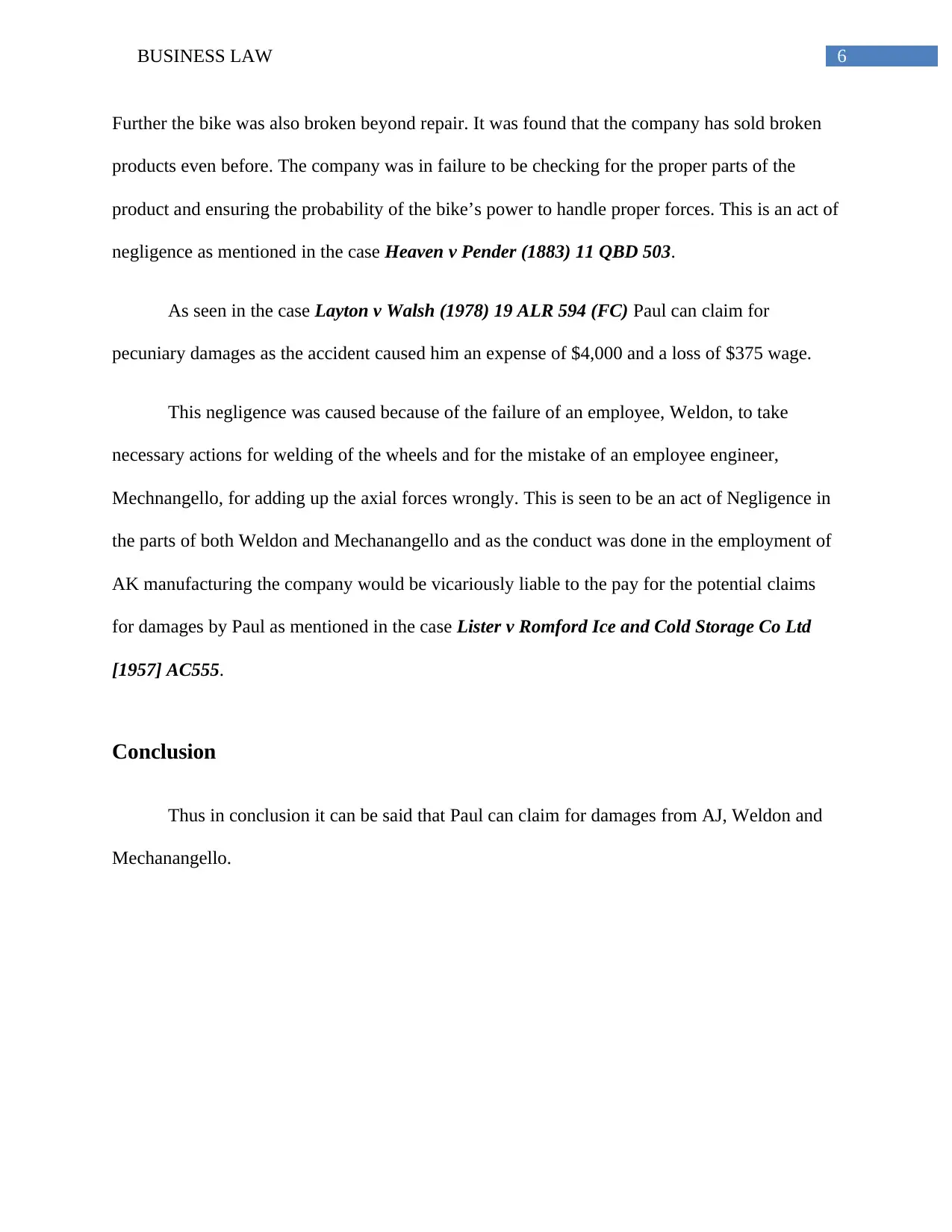
6BUSINESS LAW
Further the bike was also broken beyond repair. It was found that the company has sold broken
products even before. The company was in failure to be checking for the proper parts of the
product and ensuring the probability of the bike’s power to handle proper forces. This is an act of
negligence as mentioned in the case Heaven v Pender (1883) 11 QBD 503.
As seen in the case Layton v Walsh (1978) 19 ALR 594 (FC) Paul can claim for
pecuniary damages as the accident caused him an expense of $4,000 and a loss of $375 wage.
This negligence was caused because of the failure of an employee, Weldon, to take
necessary actions for welding of the wheels and for the mistake of an employee engineer,
Mechnangello, for adding up the axial forces wrongly. This is seen to be an act of Negligence in
the parts of both Weldon and Mechanangello and as the conduct was done in the employment of
AK manufacturing the company would be vicariously liable to the pay for the potential claims
for damages by Paul as mentioned in the case Lister v Romford Ice and Cold Storage Co Ltd
[1957] AC555.
Conclusion
Thus in conclusion it can be said that Paul can claim for damages from AJ, Weldon and
Mechanangello.
Further the bike was also broken beyond repair. It was found that the company has sold broken
products even before. The company was in failure to be checking for the proper parts of the
product and ensuring the probability of the bike’s power to handle proper forces. This is an act of
negligence as mentioned in the case Heaven v Pender (1883) 11 QBD 503.
As seen in the case Layton v Walsh (1978) 19 ALR 594 (FC) Paul can claim for
pecuniary damages as the accident caused him an expense of $4,000 and a loss of $375 wage.
This negligence was caused because of the failure of an employee, Weldon, to take
necessary actions for welding of the wheels and for the mistake of an employee engineer,
Mechnangello, for adding up the axial forces wrongly. This is seen to be an act of Negligence in
the parts of both Weldon and Mechanangello and as the conduct was done in the employment of
AK manufacturing the company would be vicariously liable to the pay for the potential claims
for damages by Paul as mentioned in the case Lister v Romford Ice and Cold Storage Co Ltd
[1957] AC555.
Conclusion
Thus in conclusion it can be said that Paul can claim for damages from AJ, Weldon and
Mechanangello.
Paraphrase This Document
Need a fresh take? Get an instant paraphrase of this document with our AI Paraphraser
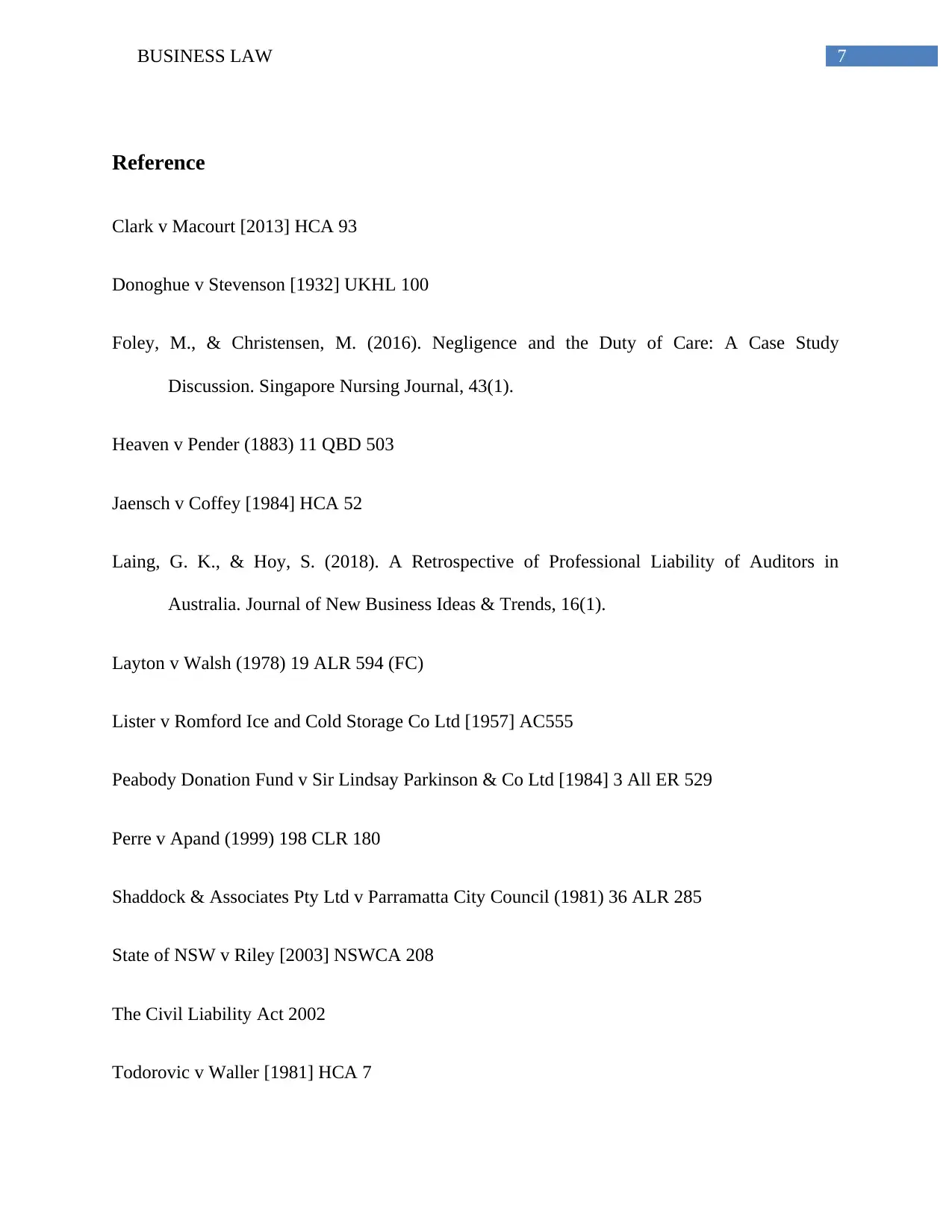
7BUSINESS LAW
Reference
Clark v Macourt [2013] HCA 93
Donoghue v Stevenson [1932] UKHL 100
Foley, M., & Christensen, M. (2016). Negligence and the Duty of Care: A Case Study
Discussion. Singapore Nursing Journal, 43(1).
Heaven v Pender (1883) 11 QBD 503
Jaensch v Coffey [1984] HCA 52
Laing, G. K., & Hoy, S. (2018). A Retrospective of Professional Liability of Auditors in
Australia. Journal of New Business Ideas & Trends, 16(1).
Layton v Walsh (1978) 19 ALR 594 (FC)
Lister v Romford Ice and Cold Storage Co Ltd [1957] AC555
Peabody Donation Fund v Sir Lindsay Parkinson & Co Ltd [1984] 3 All ER 529
Perre v Apand (1999) 198 CLR 180
Shaddock & Associates Pty Ltd v Parramatta City Council (1981) 36 ALR 285
State of NSW v Riley [2003] NSWCA 208
The Civil Liability Act 2002
Todorovic v Waller [1981] HCA 7
Reference
Clark v Macourt [2013] HCA 93
Donoghue v Stevenson [1932] UKHL 100
Foley, M., & Christensen, M. (2016). Negligence and the Duty of Care: A Case Study
Discussion. Singapore Nursing Journal, 43(1).
Heaven v Pender (1883) 11 QBD 503
Jaensch v Coffey [1984] HCA 52
Laing, G. K., & Hoy, S. (2018). A Retrospective of Professional Liability of Auditors in
Australia. Journal of New Business Ideas & Trends, 16(1).
Layton v Walsh (1978) 19 ALR 594 (FC)
Lister v Romford Ice and Cold Storage Co Ltd [1957] AC555
Peabody Donation Fund v Sir Lindsay Parkinson & Co Ltd [1984] 3 All ER 529
Perre v Apand (1999) 198 CLR 180
Shaddock & Associates Pty Ltd v Parramatta City Council (1981) 36 ALR 285
State of NSW v Riley [2003] NSWCA 208
The Civil Liability Act 2002
Todorovic v Waller [1981] HCA 7
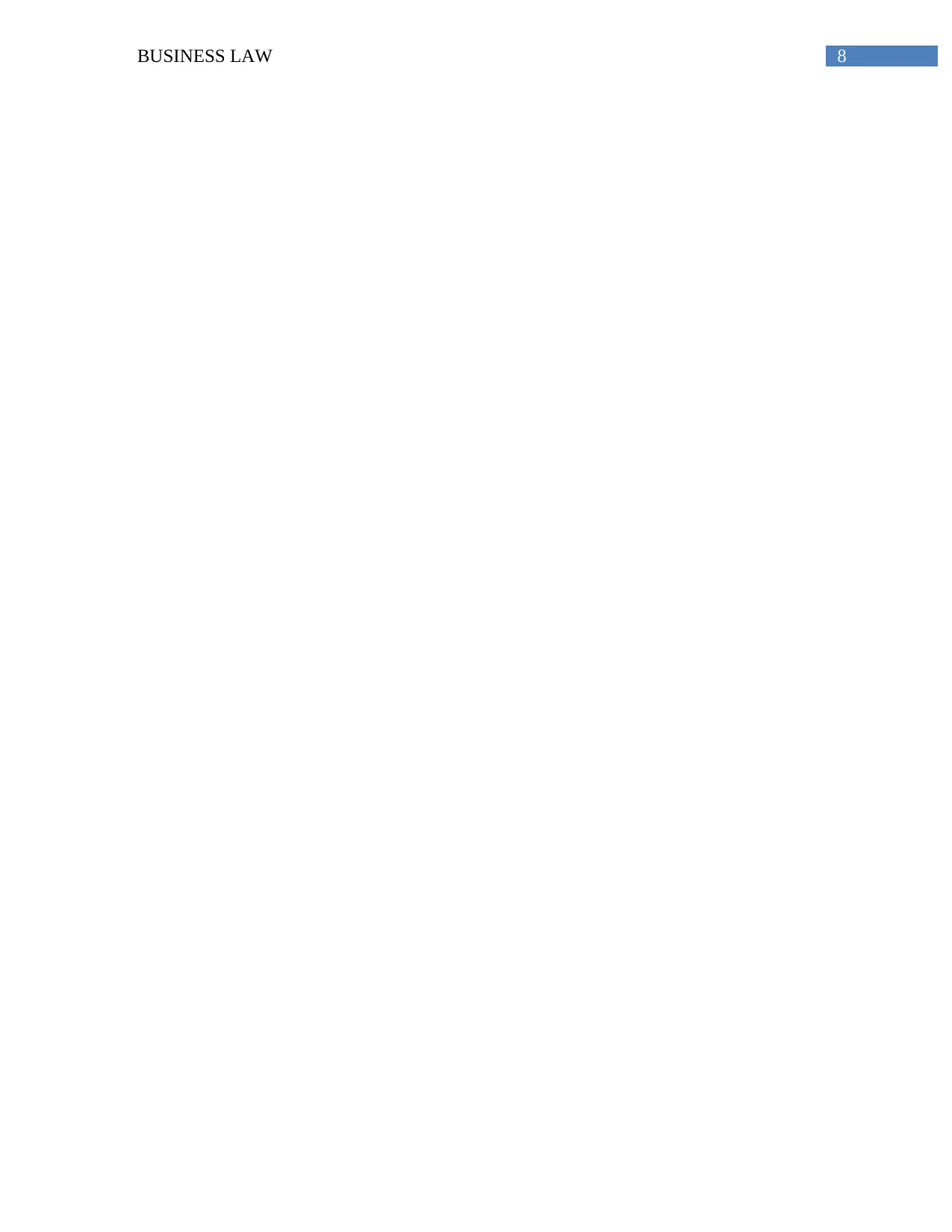
8BUSINESS LAW
⊘ This is a preview!⊘
Do you want full access?
Subscribe today to unlock all pages.

Trusted by 1+ million students worldwide
1 out of 9
Related Documents
Your All-in-One AI-Powered Toolkit for Academic Success.
+13062052269
info@desklib.com
Available 24*7 on WhatsApp / Email
![[object Object]](/_next/static/media/star-bottom.7253800d.svg)
Unlock your academic potential
Copyright © 2020–2025 A2Z Services. All Rights Reserved. Developed and managed by ZUCOL.





